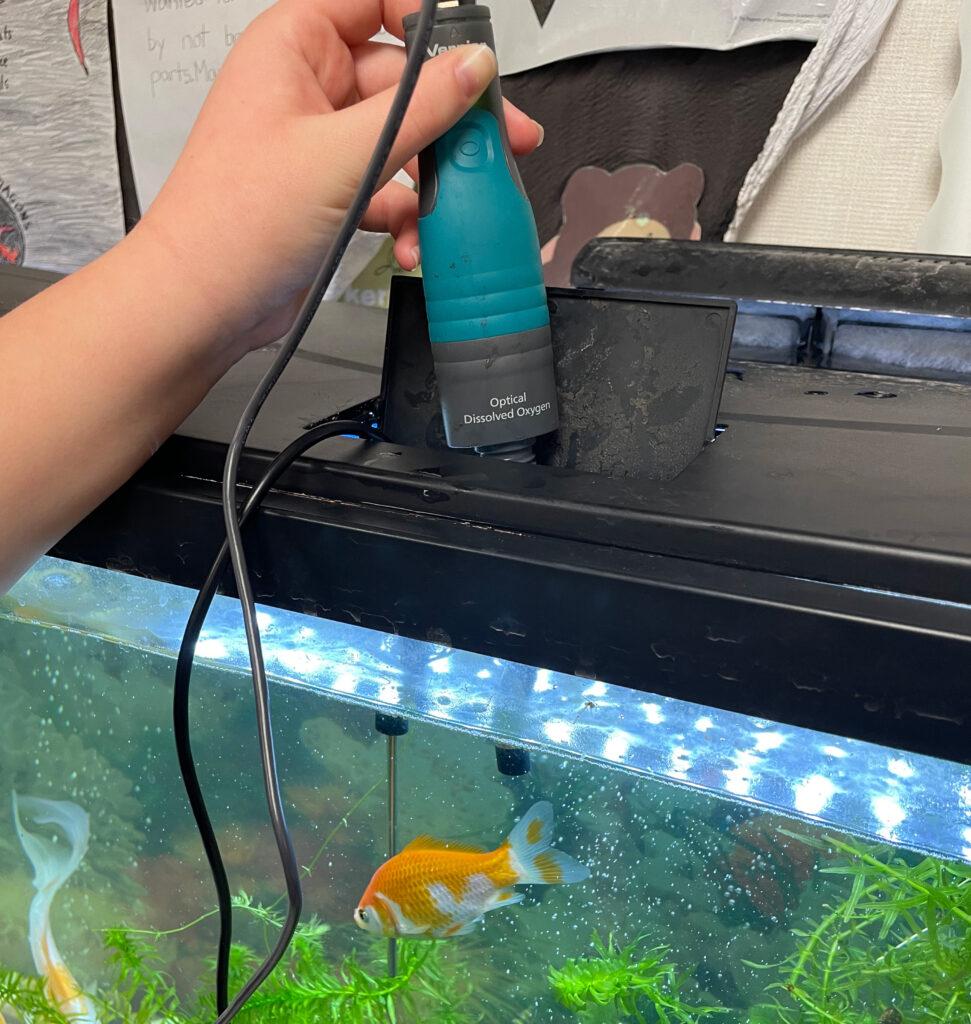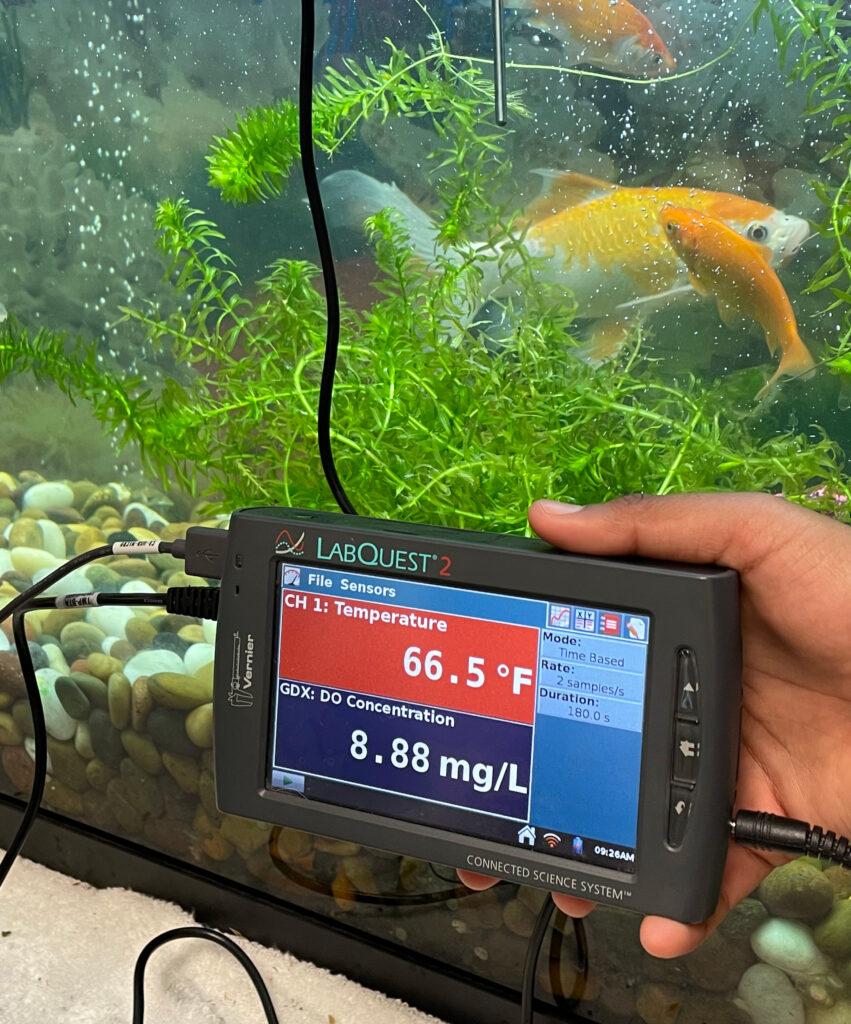
Sharing ideas and inspiration for engagement, inclusion, and excellence in STEM

In middle school science classes, data-collection technology is a great tool for promoting hands-on learning. This school year, Jeff Branchaud and his students are using an additional tool: a 55-gallon classroom aquarium.
Branchaud, who teaches sixth-grade science at Pleasanton Middle School in Pleasanton, California, and has been using Vernier technology for years, wanted a new home for two fish he acquired as part of an aquaponics program he and his students launched in 2016—and that they had to abandon due to the COVID-19 pandemic.
But what started as simply a means to get the fish out of his house has morphed into an innovative way to encourage hands-on science learning with Vernier data-collection technology.
“Once my students and I got the aquarium set up, I started thinking about all the Vernier instruments in storage that were left over from the aquaponics program,” Branchaud said. “They were just sitting in a closet, not being used. I thought, ‘What if I gave my students an opportunity to learn more about the aquarium by using the sensors I already had?’ I didn’t know if that idea would work, but I decided to try.”
“Very quickly, it started to take off,” he continued. “Plus, the kids started to show responsibility. I had been concerned about whether they would be mature enough to handle the Vernier instruments, but they rose to the occasion.”

A Fun Way to Extend the Curriculum
On Tuesday and Thursday, Pleasanton Middle School offers “Panther Pride Time,” which is a free period when students can do extra credit, participate in an extracurricular activity, or make up missed schoolwork.
Panther Pride Time also gives educators a chance to offer extended learning opportunities, which is what Branchaud has done with the aquarium program. He has also built it into his first-period science class; students who complete their work get to collect data from the aquarium as a reward.
“The learning and data collection occur at these two different times,” Branchaud said. “That way, students who aren’t in my first-period class have an opportunity to participate.”
Sneaking the Learning in the Back Door
A chemical-testing kit has been the cornerstone of the learning. Specifically, students use a kit that came with the aquarium to test the water for nitrate, ammonia, and pH levels. But that was just the jumping-off point, according to Branchaud.
“I told my students they had to do some research and learn what pH is, what ammonia is, and what nitrates are so that they could understand the science,” he said. “I also wanted them to know the safe levels for all the chemicals they were testing for. I told them, ‘OK, you’re getting the numbers from the testing kit. That’s great, but they’re just numbers.’”
That’s where the Vernier technology has come into play. Students use LabQuest®, temperature probes, Go Direct® pH Sensors, and Go Direct Optical Dissolved Oxygen Probes to collect and analyze data from the aquarium. In doing so, they get more context from the information they acquire from the chemical-testing kit—which has helped elevate learning.

“Using the Vernier instruments, my students recently determined that some of the chemical levels in the aquarium were too high,” Branchaud said. “So, it became its own problem-solving research project. The students had to figure out the cause and how to bring the chemicals back to safe levels.”
Ultimately, the students identified the solution: increase the amount of helpful bacteria, change the filter, and add a pond weed. Within two days of implementing these changes, the water was testing at healthy levels again.
“My students are having a lot of fun, but they’re also engaging in really high-level learning,” Branchaud said. “But you know what? They don’t realize it’s happening. It’s kind of like sneaking the learning in the back door.”
What Lies Ahead
The aquarium program, in no small part thanks to the Vernier technology, is helping Branchaud set his students up for postsecondary success.
“The Vernier tools we’re using are preparing my middle school students for high school science classes—and even college science classes,” he said. “In these upper-level courses, they’ll be using these sorts of tools to collect data. Down the road, I want to incorporate graphing and interpreting data, which is also something they’ll encounter after middle school.”
Students are also experiencing more near-term benefits, which Branchaud said is a great incentive for other educators to consider starting their own aquarium program.

“I’m learning that when students get involved in the aquarium program, it has a positive impact on their studies and decreases behavior issues,” he said. “For all the teachers out there, if you get an aquarium, it can make a big difference. Having students test the water and take care of the fish gives them a sense of personal responsibility, and it makes them feel empowered.”
Branchaud also said the type of aquarium program he offers could be scaled for higher grade levels and different subject areas.
“You could include something like this in high school chemistry classes or environmental science classes,” he said. “I think all science teachers could benefit, as well as all students.”
“I wish we had been able to keep carrying out the aquaponics program,” he continued. “But I’m happy we’ve found an opportunity that allows my students to use Vernier tools that had been sitting in a closet, helps them learn about data collection and the scientific method, and prepares them for high school and beyond.”
For more information about the Vernier technology used in the aquarium program, visit our website.
Share this Article

Sign up for our newsletter
Stay in the loop! Beyond Measure delivers monthly updates on the latest news, ideas, and STEM resources from Vernier.






